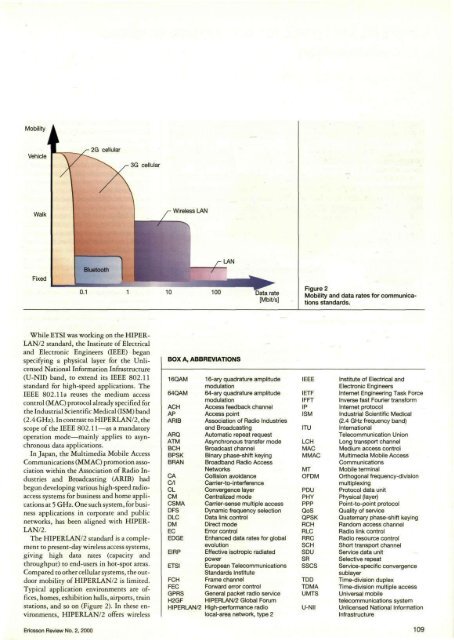HIPERLAN type 2 for broadband wireless<strong>com</strong>municationJamshid Khun-Jush, Goran Malmgren, Peter Schramm and Johan TorsnerThe aim of several standardization efforts, including GPRS, EDGE, andUMTS, is to meet the requirements being put on wireless data <strong>com</strong>munication.These standards are for wide-area wireless data services with fullmobility up to 2 Mbit/s. In addition, standards are being developed inEurope, Japan, and the US for wireless local area network multimedia<strong>com</strong>munication in the 5 GHz band.HIPERLAN/2, which is being specified by the ETSI BRAN project, willprovide data rates of up to 54 Mbit/s for short-range (up to 150 m) <strong>com</strong>municationsin indoor and outdoor environments. Almost total harmonizationwas achieved between the standardization bodies in Europe (ETSI)and Japan (ARIB) when the core parts of the specification were finalizedin 1999.In this article, the authors present an overview of the HIPERLAN/2 standardand results of link and system performance.IntroductionThe key drivers of demand for radio-basedbroadband access networks are massivegrowth in wireless and mobile <strong>com</strong>munications,the emetgence of multimedia applications,demands for high-speed Internet access,and the deregulation of the tele<strong>com</strong>municationsindustry. Present-day wirelesstele<strong>com</strong>munications networks, which areprimarily narrowband, are mostly used forcircuit-switched voice services. The evolutionof second-generation and the developmentof third-generation mobile wirelesssystems aim to enable networks to provideinstantaneous user bit rates of up to 2 Mbit/sper radio channel. This capacity will significantlyimprove packet-data and mobilemultimedia applications. In addition, evenFigure 1Current spectrum allocation of HIPERLAN/2 at 5 GHz. In Europe, a 455 MHz bandwidthhas been allocated (license-exempt band); in Japan, 100 MHz (with sharing rules); and inthe US, 300 MHz (U-NII band).higher data rates can be obtained for localarea networks using novel short-range wirelesstechnologies. Bandwidth-hungry, realtimeand interactive multimedia services,such as high-quality video distribution,client/server applications, and data-bank access,are typical applications for this technology.Therefore, new wireless networkswith broadband capabilities are beingsought to provide high-speed integratedservices (data, voice, and video) with costeffectivesupport for quality of service (QoS).Considerable research and standardizationefforts have been expended to devise appropriatetransmission and networkingtechnologies. The Internet EngineeringTask Force (IETF), the InternationalTele<strong>com</strong>munication Union (ITU) and theATM Forum are defining the fixed core network.Similarly, the Broadband Radio AccessNetworks (BRAN) project of the EuropeanTele<strong>com</strong>munications Standards Institute(ETSI) is working on standards for differentkinds of wireless broadband accessnetwork. One of these standards, called highperformanceradio local-area network, type 2(HIPERLAN/2) will provide high-speed<strong>com</strong>munications access to different broadbandcore networks and moving terminals(portable as well as mobile). 1 ' 9 In Japan, asystem that is very similar to HIPERLAN/2has also been specified. The main differencebetween it and HIPERLAN/2 is that thespectrum-sharing rule of the Japanese systemintroduces a carrier-sensing mechanism.Before beginning standardization workon HIPERLAN/2, ETSI had developed theHIPERLAN/1 standard for ad hoc networkingof portable devices. This standard mainlysupports asynchronous data transfer andapplies a multiple access mechanism—fromthe carrier-sense multiple access (CSMA)family—with collision avoidance (CA).Using the CSMA/CA technique for resolvingcontention, the scheme shares availableradio capacity between active users who attemptto transmit data during an overlappingtime span. Although HIPERLAN/1provides a means of transporting timeboundedservices, it does not control orguarantee QoS on the wireless link. It is thusconsidered a system for best-effort deliveryof data. This is what motivated ETSI to developa new generation of standards thatsupport asynchronous data and timecriticalservices (for example, packetizedvoice and video) that are bounded by specifictime delays.108 Ericsson Review No. 2, 2000
MobilityVehicleWalkFixedData rate[Mbit/s]Figure 2Mobility and data rates for <strong>com</strong>municationsstandards.While ETSI was working on the HIPER-LAN/2 standard, the Institute of Electricaland Electronic Engineers (IEEE) beganspecifying a physical layer for the UnliBOX A, ABBREVIATIONScensed National Information Infrastructure(U-NII) band, to extend its IEEE 802.11standard for high-speed applications. TheIEEE 802.11a reuses the medium accesscontrol (MAC) protocol already specified forthe Industrial Scientific Medical (ISM) band(2.4GHz).In contrast to HIPERLAN/2, thescope of the IEEE 802.11—as a mandatoryoperation mode—mainly applies to asynchronousdata applications.In Japan, the Multimedia Mobile AccessCommunications (MMAC) promotion associationwithin the Association of Radio Industriesand Broadcasting (ARIB) hadbegun developing various high-speed radioaccesssystems for business and home applicationsat 5 GHz. One such system, for businessapplications in corporate and publicnetworks, has been aligned with HIPERLAN/2.The HIPERLAN/2 standard is a <strong>com</strong>plementto present-day wireless access systems,giving high data rates (capacity andthroughput) to end-users in hot-spot areas.Compared to other cellular systems, the outdoormobility of HIPERLAN/2 is limited.Typical application environments are offices,homes, exhibition halls, airports, trainstations, and so on (Figure 2). In these environments,HIPERLAN/2 offers wireless16QAM64QAMACHAPARIBARQATMBCHBPSKBRANCAC/lCLCMCSMADFSDLCDMECEDGEEIRPETSIFCHFECGPRSH2GFHIPERLAN/216-ary quadrature amplitudemodulation64-ary quadrature amplitudemodulationAccess feedback channelAccess pointAssociation of Radio Industriesand BroadcastingAutomatic repeat requestAsynchronous transfer modeBroadcast channelBinary phase-shift keyingBroadband Radio AccessNetworksCollision avoidanceCarrier-to-interferenceConvergence layerCentralized modeCarrier-sense multiple accessDynamic frequency selectionData link controlDirect modeError controlEnhanced data rates for globalevolutionEffective isotropic radiatedpowerEuropean Tele<strong>com</strong>municationsStandards InstituteFrame channelForward error controlGeneral packet radio serviceHIPERLAN/2 Global ForumHigh-performance radiolocal-area network, type 2IEEEIETFIFFTIPISMITULCHMACMMACMTOFDMPDUPHYPPPQoSQPSKRCHRLCRRCSCHSDUSRSSCSTDDTDMAUMTSU-NIIInstitute of Electrical andElectronic EngineersInternet Engineering Task ForceInverse fast Fourier transformInternet protocolIndustrial Scientific Medical(2.4 GHz frequency band)InternationalTele<strong>com</strong>munication UnionLong transport channelMedium access controlMultimedia Mobile AccessCommunicationsMobile terminalOrthogonal frequency-divisionmultiplexingProtocol data unitPhysical (layer)Point-to-point protocolQuality of serviceQuaternary phase-shift keyingRandom access channelRadio link controlRadio resource controlShort transport channelService data unitSelective repeatService-specific convergencesublayerTime-division duplexTime-division multiple accessUniversal mobiletele<strong>com</strong>munications systemUnlicensed National InformationInfrastructureEricsson Review No. 2, 2000 109















